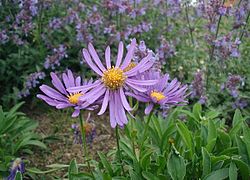Asteraceae
From Wikipedia, the free encyclopedia.
| Sunflowers | ||||||||||
|---|---|---|---|---|---|---|---|---|---|---|
 Aster alpinus |
||||||||||
| Scientific classification | ||||||||||
|
||||||||||
| Synonyms | ||||||||||
|
||||||||||
| Diversity | ||||||||||
| About 900 genera and 13'000 species | ||||||||||
| Subdivisions | ||||||||||
|
Subfamily Barnadesioideae
Subfamily Asteriodeae
|
The family Asteraceae or, alternatively, family Compositae, known as the aster, daisy or sunflower family, is a taxon of dicotyledonous flowering plants. The family name is derived from the genus Aster and refers to the star-shaped flower head of its members, typified well by the daisy. The Asteraceae is the second largest family in the Division Magnoliophyta, with some 1,100 genera and over 20,000 recognized species. Only the orchid family (Orchidaceae) is larger, with about 25,000 described species.
Plants belonging to the Asteraceae must share ALL the following characteristics (Judd et al., 1999). None of these traits, taken separately, can be considered synapomorphic.
- Inflorescence: a capitulum or flower head
- Syngenesious anthers, i.e. with the stames fused together at their edges by the anthers, forming a tube
- Ovary with basal arrangement of the ovules
- Ovules one per ovary
- Pappus (a tuft of hairs on a fruit)
- The fruit is an achene
- Sesquiterpenes present in the essential oils, but iridoids lacking.

The most common characteristic of all these plants, is that what in common parlance might be called a "flower", is an inflorescence or flower head; a densely packed cluster of many small, individual flowers, usually called florets (meaning "small flowers").
Plants in the family Asteraceae typically have one or both of two kinds of florets. The outer perimeter of a flower head like that of a sunflower is composed of florets possessing a long strap-like petal, termed a ligule; these are the ray florets. The inner portion of the flower head (or disc) is composed of small flowers with tubular corollas; these are the disc florets. The composition of asteraceous inflorescences varies from all ray flowers (like dandelions, genus Taraxacum) to all disc flowers (like pineapple weeds).
The composite nature of the inflorescences of these plants led early taxonomists to call this family the Compositae. Although the rules governing naming conventions for plant families state that the name should come from the type genus, in this case Aster and thus Asteraceae. However, the long prevailing name Compositae is also authorized as an alternative family name (ICBN Art. 18.6).
The numerous genera are divided into about 13 tribes. Only one of these, Lactuceae, is considered distinct enough to be a subfamily (subfamily Cichorioideae); the remainer, which are mostly overlapping, are put in the subfamily Asteroideae (Wagner, Herbst, and Sohmer, 1990).
Uses
Commercially important plants in the Asteraceae include the food crops lettuce, chicory and sunflower. Guayule is a source of hypoallergenic latex.
Many members of Asteracae are copious nectar producers and are useful for evaluating pollinator populations during their bloom. Centaurea (knapweed), Helianthus annuus (domestic sunflower), and some species of Solidago (goldenrod) are major "honey plants" for beekeepers. Solidago produces relatively high protein pollen, which helps honeybees overwinter.
References
- ITIS report 2002-09-10
- International Code of Botanical Nomenclature (ICBN, St. Louis Code). 1999. website (Published as Regnum Vegetabile 138. Koeltz Scientific Books, Königstein. ISBN 3904144227)
- Walters, Dirk R. and David J. Keil (1996). Vascular plant taxonomy. 4th ed. Kendall/Hunt Publishing Company. Dubuque, Iowa.
- Wagner,W.L., D.R. Herbst, and S.H. Sohmer. 1990. Manual of the Flowering Plants of Hawai‘i, Vol. I. University of Hawaii Press, Honolulu. 988 pp.
- Judd, W.S., C.S. Campbell, E.A. Kellogg, and P.F. Stevens. 1999. Plant Systematics: A Phylogenetic Approach. Sinauer Associates, Sunderland, MA.






